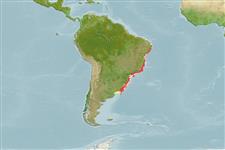Environment: milieu / climate zone / depth range / distribution range
Écologie
marin; saumâtre; profondeur 0 - 50 m (Ref. 189). Subtropical; 2°S - 39°S, 60°W - 32°W (Ref. 189)
Southwest Atlantic: Ceará, Brazil southward to Mar de la Plata, Argentina.
Taille / Poids / Âge
Maturity: Lm ? range ? - ? cm
Max length : 14.9 cm TL mâle / non sexé; (Ref. 122735); common length : 6.5 cm SL mâle / non sexé; (Ref. 189); poids max. publié: 24.10 g (Ref. 122735)
Épines dorsales (Total): 0; Épines anales 0; Rayons mous anaux: 16 - 19. Snout long, pointed, about 3/4 eye diameter; maxilla moderate, tip not sharply pointed, not or only just reaching to hind border of pre-operculum; gill cover canals of panamensis-type. Anal fin short, its origin below or behind midpoint of dorsal fin base. A broad silver stripe along flank, about 3/4 eye diameter.
A schooling species found in coastal waters, but also entering brackish water. More data needed (Ref. 189). Found in markets (Ref. 37032). Largely utilized as bait for commercial fishery, oil, flour, and also canned fish (Ref. 103984).
Life cycle and mating behavior
Maturité | Reproduction | Frai | Œufs | Fécondité | Larves
Spawn in school (Ref. 205).
Whitehead, P.J.P., G.J. Nelson and T. Wongratana, 1988. FAO Species Catalogue. Vol. 7. Clupeoid fishes of the world (Suborder Clupeoidei). An annotated and illustrated catalogue of the herrings, sardines, pilchards, sprats, shads, anchovies and wolf-herrings. FAO Fish. Synop. 125(7/2):305-579. Rome: FAO. (Ref. 189)
Statut dans la liste rouge de l'IUCN (Ref. 130435)
Menace pour l'homme
Harmless
Utilisations par l'homme
Pêcheries: intérêt commercial mineur
Plus d'informations
RéférencesAquacultureProfil d'aquacultureSouchesGénétiqueElectrophoresesHéritabilitéPathologiesTraitementNutrientsMass conversion
CollaborateursImagesStamps, Coins Misc.SonsCiguateraVitesseType de nageSurface branchialeOtolithesCerveauxVision
Outils
Articles particuliers
Télécharger en XML
Sources Internet
Estimates based on models
Preferred temperature (Ref.
123201): 15.8 - 27.2, mean 22.6 °C (based on 64 cells).
Phylogenetic diversity index (Ref.
82804): PD
50 = 0.5000 [Uniqueness, from 0.5 = low to 2.0 = high].
Bayesian length-weight: a=0.00550 (0.00324 - 0.00932), b=3.11 (2.97 - 3.25), in cm total length, based on LWR estimates for this species & Genus-body shape (Ref.
93245).
Niveau trophique (Ref.
69278): 3.4 ±0.4 se; based on size and trophs of closest relatives
Generation time: 0.7 ( na - na) years. Estimated as median ln(3)/K based on 1
growth studies.
Résilience (Ref.
120179): Haut, temps minimum de doublement de population inférieur à 15 mois (Preliminary K or Fecundity.).
Fishing Vulnerability (Ref.
59153): Low vulnerability (10 of 100).
